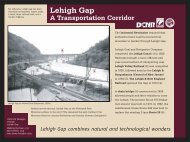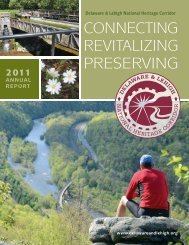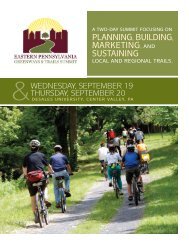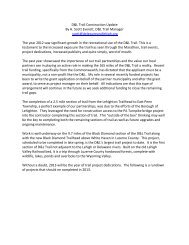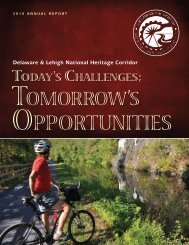download the full guide - Lehigh Gap Nature Center
download the full guide - Lehigh Gap Nature Center
download the full guide - Lehigh Gap Nature Center
- No tags were found...
Create successful ePaper yourself
Turn your PDF publications into a flip-book with our unique Google optimized e-Paper software.
PalmertonSuperfund site47From 1898 to 1980, zinc smelters in Palmerton,Carbon County, operated and gave off air pollutionthat, because of geography and a lack of pollutioncontrol technology at <strong>the</strong> time, destroyed vegetation onapproximately 3,000 acres surrounding <strong>the</strong> town, muchof it on <strong>the</strong> Kittatinny Ridge at <strong>Lehigh</strong> <strong>Gap</strong>. In 1983, <strong>the</strong>site was designated one of <strong>the</strong> nations first Superfundsites, making it <strong>the</strong> target of a U.S. EnvironmentalProtection Agency (EPA) mandated clean up. Toxic heavymetals from <strong>the</strong> smelting contaminated <strong>the</strong> top 6-8inches of soil, rendering it sterile.An effort on <strong>the</strong> west side of <strong>the</strong> <strong>Lehigh</strong> River in <strong>the</strong>early 1990s resulted in successful establishment ofvegetation on 700 acres, however, that effort requiredextensive road systems that changed <strong>the</strong> face of <strong>the</strong>mountain, and failed to meet all <strong>the</strong> requirements setforth by EPA. The re-vegetation process stalled until2003, when <strong>the</strong> nonprofit Wildlife Information <strong>Center</strong>purchased 750 acres on <strong>the</strong> west side of <strong>the</strong> <strong>Lehigh</strong>River, creating <strong>Lehigh</strong> <strong>Gap</strong> <strong>Nature</strong> <strong>Center</strong>.Using innovative methods of planting, <strong>the</strong> <strong>Nature</strong><strong>Center</strong>, in partnership with EPA and responsible partyViacom International (now CBS Operations), was ableto establish native, warm-season, prairie grasses onits part of <strong>the</strong> Superfund site. These methods havebeen used on most of <strong>the</strong> o<strong>the</strong>r land in <strong>the</strong> PalmertonSuperfund area, which is becoming green again for <strong>the</strong>first time in 50 years.To see <strong>the</strong> restoration project, visit <strong>Lehigh</strong><strong>Gap</strong> <strong>Nature</strong> <strong>Center</strong>, page 61, or visit www.lgnc.org.October 2002, Dan KunkleOctober 2008, Dan KunkleWest Plant, Palmerton Zinc Co. circa 1950.Courtesy C. Reinhart, Palmerton Camera Club



